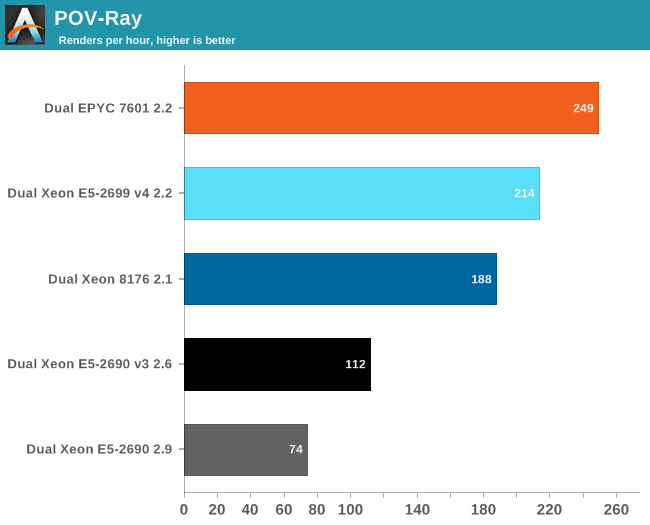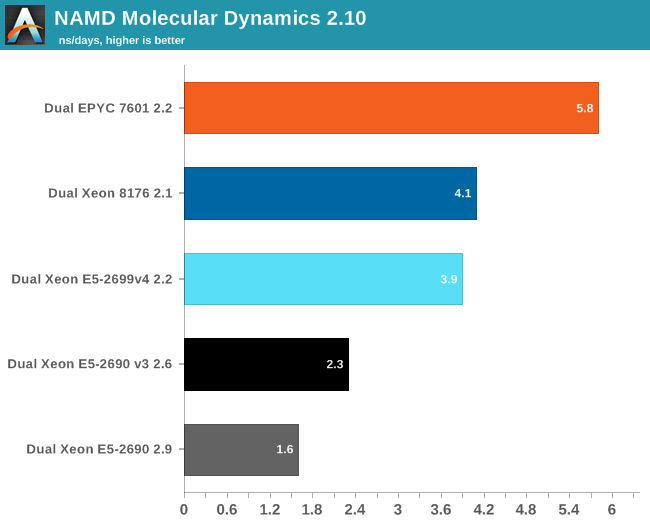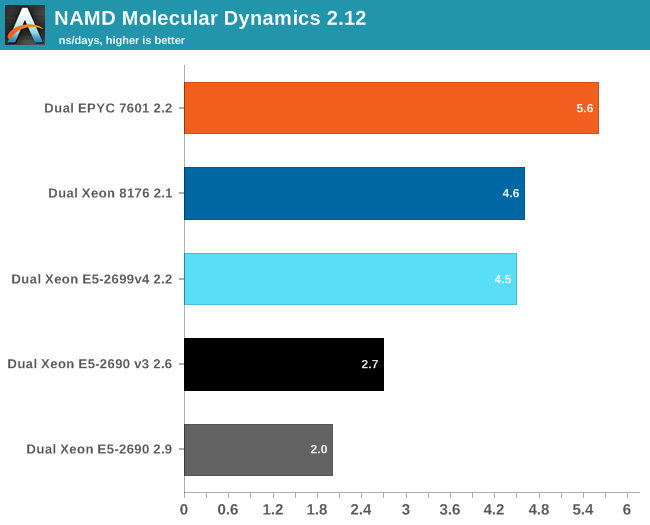Sizing Up Servers: Intel's Skylake-SP Xeon versus AMD's EPYC 7000 - The Server CPU Battle of the Decade?
by Johan De Gelas & Ian Cutress on July 11, 2017 12:15 PM EST- Posted in
- CPUs
- AMD
- Intel
- Xeon
- Enterprise
- Skylake
- Zen
- Naples
- Skylake-SP
- EPYC
Floating Point
Normally our HPC benchmarking is centered around OpenFoam, a CFD software we have used for a number of articles over the years. However, since we moved to Ubuntu 16.04, we could not get it to work anymore. So we decided to change our floating point intensive benchmark for now. For our latest article, we're testing with C-ray, POV-Ray, and NAMD.
The idea is to measure:
- A FP benchmark that is running out of the L1 (C-ray)
- A FP benchmark that is running out of the L2 (POV-Ray)
- And one that is using the memory subsytem quite often (NAMD)
Floating Point: C-ray
C-ray is an extremely simple ray-tracer which is not representative of any real world raytracing application. In fact, it is essentially a floating point benchmark that runs out of the L1-cache. Luckily it is not as synthetic and meaningless as Whetstone, as you can actually use the software to do simple raytracing.
We use the standard benchmarking resolution (3840x2160) and the "sphfract" file to measure performance. The binary was precompiled.

Wow. What just happened? It looks like a landslide victory for the raw power of the four FP pipes of Zen: the EPYC chip is no less than 50% faster than the competition. Of course, it is easy to feed FP units if everything resides in the L1. Next stop, POV-Ray.
Floating Point: POV-Ray 3.7

POV-Ray is known to run mostly out of the L2-cache, so the massive DRAM bandwidth of the EPYC CPU does not play a role here. Nevertheless, the EPYC CPU performance is pretty stunning: about 16% faster than Intel's Xeon 8176. But what if AVX and DRAM access come in to play? Let us check out NAMD.
Floating Point: NAMD
Developed by the Theoretical and Computational Biophysics Group at the University of Illinois Urbana-Champaign, NAMD is a set of parallel molecular dynamics codes for extreme parallelization on thousands of cores. NAMD is also part of SPEC CPU2006 FP. In contrast with previous FP benchmarks, the NAMD binary is compiled with Intel ICC and optimized for AVX.
First, we used the "NAMD_2.10_Linux-x86_64-multicore" binary. We used the most popular benchmark load, apoa1 (Apolipoprotein A1). The results are expressed in simulated nanoseconds per wall-clock day. We measure at 500 steps.

Again, the EPYC 7601 simply crushes the competition with 41% better performance than Intel's 28-core. Heavily vectorized code (like Linpack) might run much faster on Intel, but other FP code seems to run faster on AMD's newest FPU.
For our first shot with this benchmark, we used version 2.10 to be able to compare to our older data set. Version 2.12 seems to make better use of "Intel's compiler vectorization and auto-dispatch has improved performance for Intel processors supporting AVX instructions". So let's try again:

The older Xeons see a perforance boost of about 25%. The improvement on the new Xeons is a lot lower: about 13-15%. Remarkable is that the new binary is slower on the EPYC 7601: about 4%. That simply begs for more investigation: but the deadline was too close. Nevertheless, three different FP tests all point in the same direction: the Zen FP unit might not have the highest "peak FLOPs" in theory, there is lots of FP code out there that runs best on EPYC.










219 Comments
View All Comments
tmbm50 - Wednesday, July 12, 2017 - link
Windows licensing is irrespective of virtualization.If you run a vm with a single vCPU on a server with 32 cores, you must license all 32 cores. KVM, ESXi...doesnt matter.
I'm sure most folks ignore that point in the license but if your an enterprise and get audited it's enforced.
nils_ - Wednesday, July 19, 2017 - link
Oracle does the same, and if your environment supports migration to other hosts you'd have to license those too (just in case). It's sort of criminal really.pepoluan - Friday, July 28, 2017 - link
I wonder, though, how does AWS managed to offer per-instance Windows licensing for EC2?Because, by that logic, EVERY Windows instance needs to be licensed against ALL cores in an Availability Zone...
Rοb - Sunday, July 23, 2017 - link
From very brief research it looks like for you're in for $6K per 16 Cores for the Datacenter Edition, trying to run the Software on a 4S 32 Core would cost 64x as much (excluding any Bulk Buy pricing you might be able to request).If you bought SM Fat Twins everything would be separated with less loss of density; for the money saved on Licensing would it pay off.
You want to conduct your business lawfully and can charge the customer what it costs plus profit - that's what it costs, want something different the price will probably be different.
Most Software that has per Core Licenses costs a fair bit and has thought it out so someone can't (lawfully) buy a single License and then run the Software on a much more powerful machine.
Take a deep breath and consider that if you ran it on a Phi x200 in x86 Mode that it would run slowly and you'd be charged for 256 Cores per CPU - so don't do that.
I don't want to sound unsympathetic but if the Vendor didn't make money then they wouldn't have incentive to write the Software.
Convince your customers to switch to free Software or for those prices write your own.
What is the complaint exactly, have a Rack Unit Fee, an Electricity Fee, a CPU Fee, a Software Fee, etc., and tell the customer that XYZ costs that much but if they get WYZ it will only cost so much instead.
Assuming everyone obeys the Law and pays the same for Electricity, Cooling, Electronics, Software and Labor then it's only the percentage of Profit where the difference in price lies - or in other words someone will always charge less (and not be 'audited' / as honest / as intelligent and hard working as your Team).
Let the people who you buy your Software from know your complaint and options, we can't be of much more help to you other than the years of service some of us devote to free and pay Software.
rocky12345 - Wednesday, July 12, 2017 - link
Great article as always I found it very well written and there was a lot of information to take in. It was good to see AMD chips doing this good. Bang for the buck seems to be in AMD's court in both the server market and consumer markets now.To those saying oh in the real world big companies would not be upgrading there software to the latest because of money that may be lost. You guys have a solid point there. BUT these tests are not being done in a real world company that depends on their servers to be up 100% of the time. These are just in house tests done to benchmark the new CPU's so yes the latest and greatest versions of the software can be & should be used. This shows exactly what the new CPU's can do when the software is updated to support the latest and greatest hardware. DO you actually think a huge company when buying new server clusters asks for software that is 5 -10 years olds I am fairly sure they do not. They want the most update to date software that is optimized for the new hardware they are spending big bucks on. They want it to be 100% stable and they also want the latest and greatest because of the fact that they probably will never update the software again or at least not for 5-7 years or more. So testing with old builds of software is very unrealistic and does not show the hardware at it's best and also not what a company is looking fro when buying new hardware.
With that said this is still a great write up and deserves a lot of praise.
rahvin - Wednesday, July 12, 2017 - link
I think it's a great comparison article too, you know it's pretty unbiased when both the Intel and AMD fanboi's are out in force criticizing the article for bias.My main comment is that Intel is crazy with those prices on the platinum chips. Those prices are easily two times the previous generation. This is the result of AMD being absent from the server market, that is Intel running processor prices up to the prices that Sun, IBM and HP used to charge in the worst of the enterprise server days. $13k for a Xeon, you've got to be shitting me.
Here's to hoping AMD mops the floor with them and causes prices to crater just like the last time Opteron was competitive. I remember the days when the highest end Xeon was less than $1000. These days the bottom end Xeons are pricing at $1000 and the high ends are 13X that much. Again, I pray AMD can get 25% market share and knock these prices back into reasonable territory. I also hope AMD makes a ton of money and can keep it up with competitive designs (even if it is doubtful because their management is garbage).
Rοb - Sunday, July 23, 2017 - link
Rahvin writes: "$13K for a Xeon ...".There's more to it than that, read the Fine Print; Intel has all kinds of expensive/inexpensive (depending upon your point of view).
See this Comparison: https://ark.intel.com/compare/120498,120499 .
Which is "less expensive":
Intel® Xeon® Platinum 8180M Processor (28 Cores) for $13,011.00
or
Intel® Xeon® Platinum 8156 Processor (4 Cores) for $7,007.00
So which is less 13 or 7 vs. 28 or 4?
You can't just look at one number.
There are other Technical Points, AMD doesn't have: AVX-512, OmniPath 400Gbps, 8-way Motherboards, etc.
If you MUST have what Intel offers then there's only one choice, if you can work around those things and get along with AMD then you're saving money.
If you wanted bleading edge performance then you'd be looking at Spark or Power; some complain that would deny the ability to play Crysis (and that due to their importance people stay up worrying about their issues).
Which is "best" is often easy to say given a narrow definition, which is best in every possible circumstance can be more of a challenge.
Disclaimer: I don't work at either place and intend to buy Epyc 7nm.
hahmed330 - Wednesday, July 12, 2017 - link
Jolly Good! AMD just smoked Intel's bacon!Impressive showing! Outstanding just outstanding!
Shankar1962 - Wednesday, July 12, 2017 - link
Yeah thats why AMD is still in losses and Intel is making net profits of ~$11billion plus each yearThey are gaining share by trying to sell their so called top products for cheap prices
Wondering who is getting smoked
PixyMisa - Thursday, July 13, 2017 - link
Epyc has been out for three weeks.